A Design for SDN-Based Identifier–Locator Separation Architecture on IoT Networks
Abstract
:Featured Application
Abstract
1. Introduction
2. Related Work
2.1. Existing Project in the Field
2.2. Host-Based Identifier–Locator Separation Schemes
2.3. Network-Based Identifier–Locator Separation Schemes
2.4. SDN and OpenFlow
3. Proposed SDN-Based Identifier–Locator Separation Architecture for IoT Networks
3.1. EID and LOC
3.2. Proposed Architecture
3.3. Operations of ARs and OFSs
3.4. Main Procedure
3.4.1. Registration and Packet Forwarding Process
| Algorithm 1. Registration and Packet forwarding |
| 1: receive a packet pkt from the OFS |
| 2: if destination is MY ADDRESS (EID or LOC of this AR) then |
| 3: if pkt:type is L2 ATTACHMENT NOTIFY then |
| 4: save MN-ID from pkt; generate using ; generate using |
| 5: LOOKUP EIDRoutingTable for the next hop port(D) |
| 6: send EID REG REQ(, ) to h_AR() |
| 7: add (, ) to BindingUpdateList; add flow table entry ( → ) |
| 8: else if pkt:type is EID registration reply then |
| 9: done |
| 10: end if |
| 11: else if pkt:dst is in MY EID address block then |
| 12: if pkt:type is EID registration request then |
| 13: add <EID,LOC> to BindingCache; add a flow table entry(pkt:EID → pkt:LOC) |
| 14: send EID registration reply to pkt’s src |
| 15: end if |
| 16: else if pkt:dst is not in MY EID address block then |
| 17: LOOKUP EID routing table(dst) for next hop port(D); add a flow table entry (, D); Packet-Out(pkt) |
| 18: else |
| 19: drop packet |
| 20: end if |
3.4.2. Route Optimization Process
| Algorithm 2. Route Optimization |
| 1: Require: the AR acts as s_AR |
| 2: if pkt:src is in BindingUpdateList then |
| 3: send EID query request to pkt:dst |
| 4: else if pkt:dst is MY EID ADDRESS(EID of s_AR) then |
| 5: if pkt:type is EID query reply then |
| 6: add a flow table entry (pkt:dst → pkt:loc) |
| 7: else |
| 8: drop packet |
| 9: end if |
| 10: else |
| 11: if pkt:dst is in MY EID address block then |
| 12: if pkt:type is EID registration request then |
| 13: add <EID,LOC> to BindingCache; add a flow table entry(pkt:EID → pkt:LOC) |
| 14: send EID registration reply to pkt’s src |
| 15: end if |
| 16: end if |
| 17: Require: the AR acts as h_AR |
| 18: if pkt:dst is in MY EID ADDRESS BLOCK then |
| 19: if pkt:type is EID query request then |
| 20: lookup BindingCache(pkt:dst); send EID query reply with () to pkt.src |
| 21: else |
| 22: drop packet |
| 23: end if |
| 24: else |
| 25: if pkt:dst is not in MY EID address block then |
| 26: LOOKUP EID routing table(dst) for next hop port(D); add a flow table 27: entry (, D) |
| 28: Packet-Out(pkt) |
| 29: else |
| 30: drop packet |
| 31: end if |
| 32: end if |
4. Cost Model Analysis
- : The average number of hops between the node and the OFS
- : The average number of hops between the AR and the OFS
- : The average number of hops between the OFSs
4.1. Signaling Cost
4.1.1. MOFI
4.1.2. Proposed Scheme
4.2. Packet Delivery Cost
4.2.1. MOFI
4.2.2. Proposed Scheme
5. Results
6. Conclusions
Author Contributions
Funding
Conflicts of Interest
References
- Romero-Gázquez, J.L.; Bueno-Delgado, M. Software Architecture Solution Based on SDN for an Industrial IoT Scenario. Wirel. Commun. Mob. Comput. 2018, 2018, 2946575. [Google Scholar] [CrossRef]
- Khusanbek, G.; Tai-Myoung, C. Comprehensive Survey on Internet of Things, Architecture, Security Aspects, Applications, Related Techologies, Economic Perspective, and Future Directions. J. Inf. Process. Syst. 2019, 15, 797–819. [Google Scholar]
- Park, J.H.; Salim, M.M.; Jo, J.H.; Sicato, J.C.S.; Rathore, S.; Park, J.H. CIoT-Net: A scalable cognitive IoT based smart city network architecture. Hum.-Cent. Comput. Inf. Sci. 2019, 9, 29. [Google Scholar] [CrossRef]
- Mohammadi, V.; Rahmani, A.M.; Darwesh, A.M.; Sahafi, A. Trust-based recommendation systems in Internet of Things: A systematic literature review. Hum.-Cent. Comput. Inf. Sci. 2019, 9, 21. [Google Scholar] [CrossRef]
- Moskowitz, R.; Nikander, P.; Jokela, P. Host Identity Protocol: Internet Engineering Task Force (IETF) network working group, RFC5201. In Technical Report; IETF: Fremont, CA, USA, 2008. [Google Scholar]
- Nordmark, E.; Bagnulo, M. Shim6: Level 3 Multihoming Shim Protocol for IPv6, RFC5533. In Technical Report; IETF: Fremont, CA, USA, 2009. [Google Scholar]
- Atkinson, R.J.; Bhatti, S.N. Identifier-Locator Network Protocol (ILNP) Architectural Description, RFC6740. In Technical Report; IETF: Fremont, CA, USA, 2012. [Google Scholar]
- Farinacci, D.; Fuller, V.; Meyer, D.; Lewis, D. The Locator/ID Separation Protocol (LISP), RFC6830. In Technical Report; IETF: Fremont, CA, USA, 2013. [Google Scholar]
- Gohar, M.; Koh, S.J. Network-based Distributed Mobility Control in Localized Mobile LISP Networks. Commun. Lett. 2012, 16, 104–107. [Google Scholar] [CrossRef]
- Menth, M.; Klein, D.; Hartmann, M. Improvements to LISP Mobile Node. In Proceedings of the 22nd International Teletraffic Congress (ITC 22), Amsterdam, The Netherlands, 7–9 September 2010. [Google Scholar]
- Ratnasamy, S.; Francis, P.; Handley, M.; Karp, R.; Shenker, S. A scalable content-addressable network. ACM SIGCOMM Comput. Commun. Rev. 2001, 31, 161–172. [Google Scholar] [CrossRef]
- SDN Overview. Available online: http://www.opennetworking.org (accessed on 10 December 2019).
- ONF White Paper. Software-Defined Networking: The New Norm for Networks. Open Networking Foundation. Available online: https://www.opennetworking.org/images/stories/downloads/sdn-resources/white-papers/wp-sdn-newnorm.pdf (accessed on 10 December 2019).
- Available online: https://www.cisco.com (accessed on 10 December 2019).
- Available online: https://www.spirent.com (accessed on 10 December 2019).
- Kang, H.W.; Kim, J.I.; Koh, S.J. DHT-based Identifier-Locator Mapping Management for Mobile Oriented Future Internet. In Proceedings of the 18th Asia-Pacific Conference on Communications (APCC), Jeju Island, Korea, 15–17 October 2012; pp. 786–791. [Google Scholar]
- Kim, J.I.; Jung, H.; Koh, S.J. Mobile Oriented Future Internet (MOFI): Architectural Design and Implementations. ETRI J. 2013, 35, 666–676. [Google Scholar] [CrossRef]
- Luo, H.; Qin, Y.; Zhang, H. A DHT-Based Identifier-to-Locator Mapping Approach for a Scalable Internet. IEEE Trans. Parallel Distrib. Syst. 2009, 20, 1790–1802. [Google Scholar]
- OpenFlow Switch Specification, Version 1.5.1; Open Networking Foundation. Available online: https://www.opennetworking.org/wp-content/uploads/2014/10/openflow-switch-v1.5.1.pdf (accessed on 1 October 2018).
- Ha, N.; Kim, N. Efficient Flow Table Management Scheme in SDN-Based Cloud Computing Networks. J. Inf. Process. Syst. 2018, 14, 228–238. [Google Scholar]
- Montenegro, G.; Kushalnagar, N.; Hui, J.; Culler, D. Transmission of IPv6 Packets over IEEE 802.15.4 Networks. Internet Propos. Stand. RFC 2007, 4944, 130. [Google Scholar]
- Baddeley, M.; Nejabati, R.; Oikonomou, G.; Sooriyabandara, M.; Simeonidou, D. Evolving SDN for Low-Power IoT Networks. In Proceedings of the 2018 4th IEEE Conference on Network Softwarization and Workshops (NetSoft), Ontreal, QC, Canada, 25–29 June 2018. [Google Scholar]
- Nikander, P.; Laganier, J.; Dupont, F. An IPv6 Prefix for Overlay Routable Cryptographic Hash Identifiers (ORCHID); RFC4843; IETF: Fremont, CA, USA, 2007. [Google Scholar]
- Deering, S.; Hinden, R. Internet Protocol; Version 6(IPv6), RFC2460; IETF: Fremont, CA, USA, 1998. [Google Scholar]
- Thomson, S.; Narten, T.; Jinmei, T. IPv6 Stateless Address Autoconfiguration; RFC4862; IETF: Fremont, CA, USA, 2007. [Google Scholar]
- Rhim, H.; Tamine, K.; Abassi, R.; Sauveron, D.; Guemara, S. A multi-hop graph-based approach for an energy-efficient routing Protocol in wireless sensor networks. Hum.-Cent. Comput. Inf. Sci. 2018, 8, 1–21. [Google Scholar] [CrossRef]
- Jeong-Joon, K. Routing Techniques for Data Aggregation in Sensor Networks. J. Inf. Process. Syst. 2018, 14, 396–417. [Google Scholar]
- Jong-Hyouk, L.; Tai-Myoung, C.; Sri, G. A Comparative Signaling Cost Analysis of Hierarchical Mobile IPv6 and Proxy Mobile IPv6. In In Proceedings of the IEEE 19th International Symposium, Personal, Indoor and Mobile Radio Communications, Cannes, France, 15–18 September 2008; pp. 1–6. [Google Scholar]
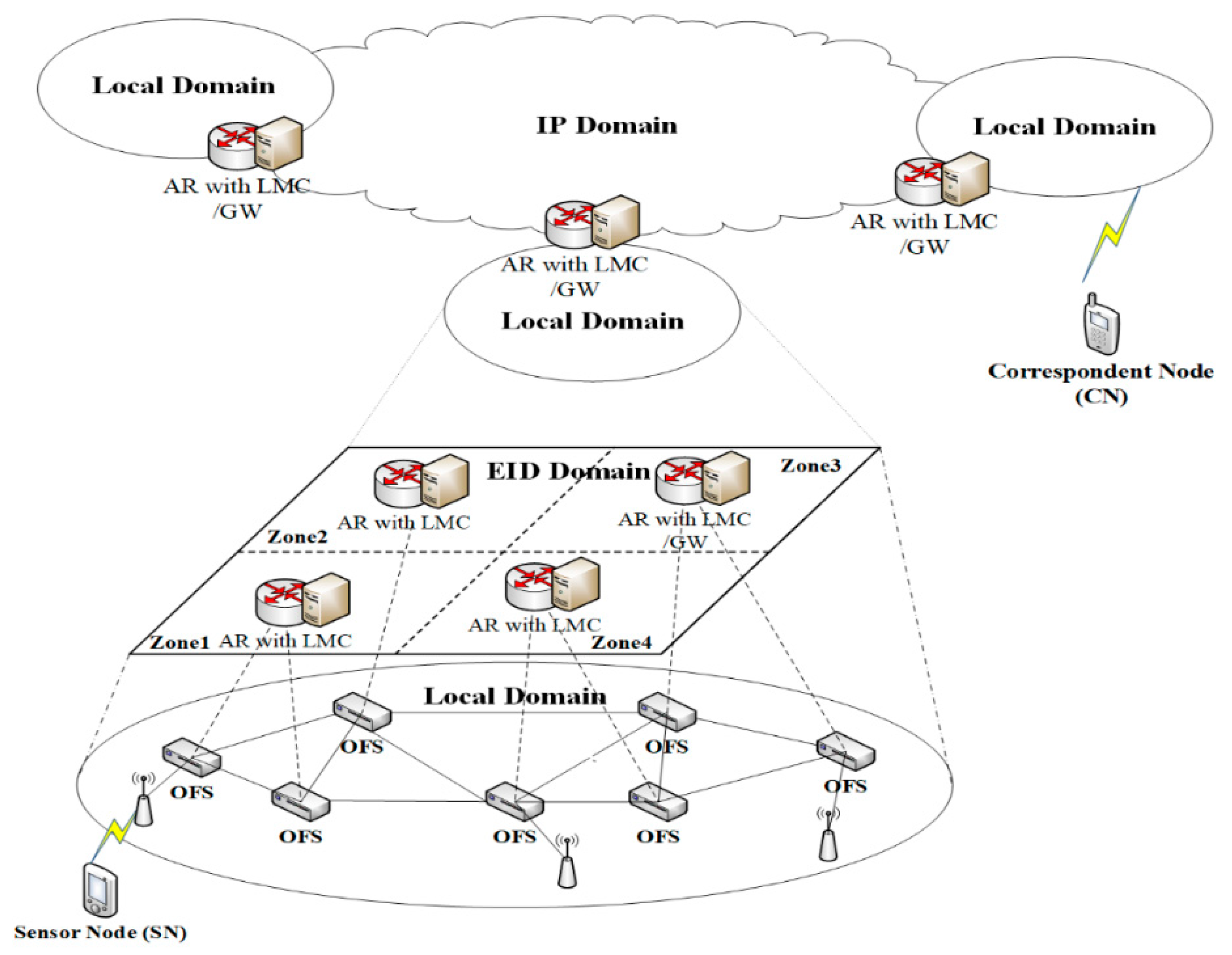
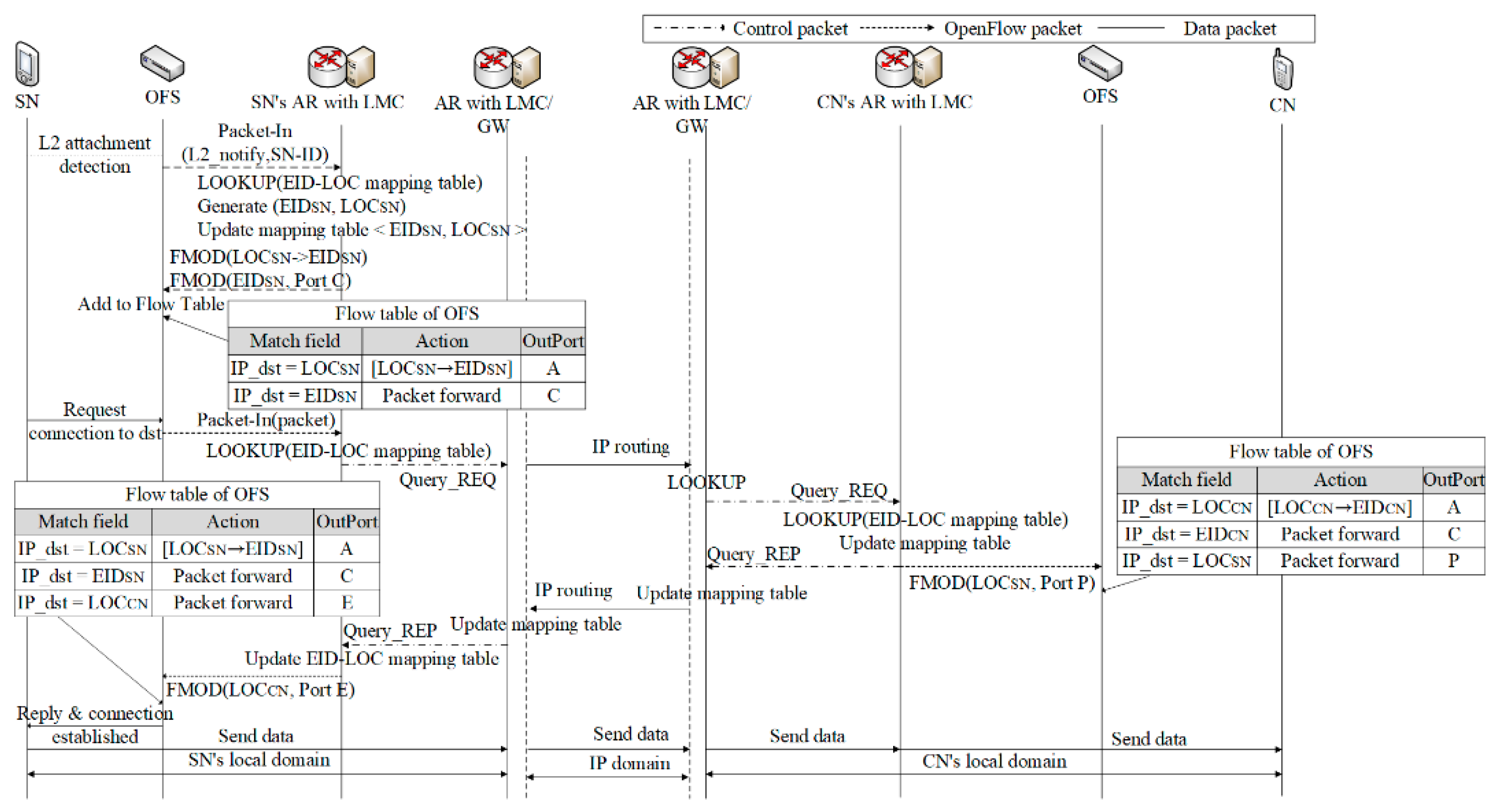

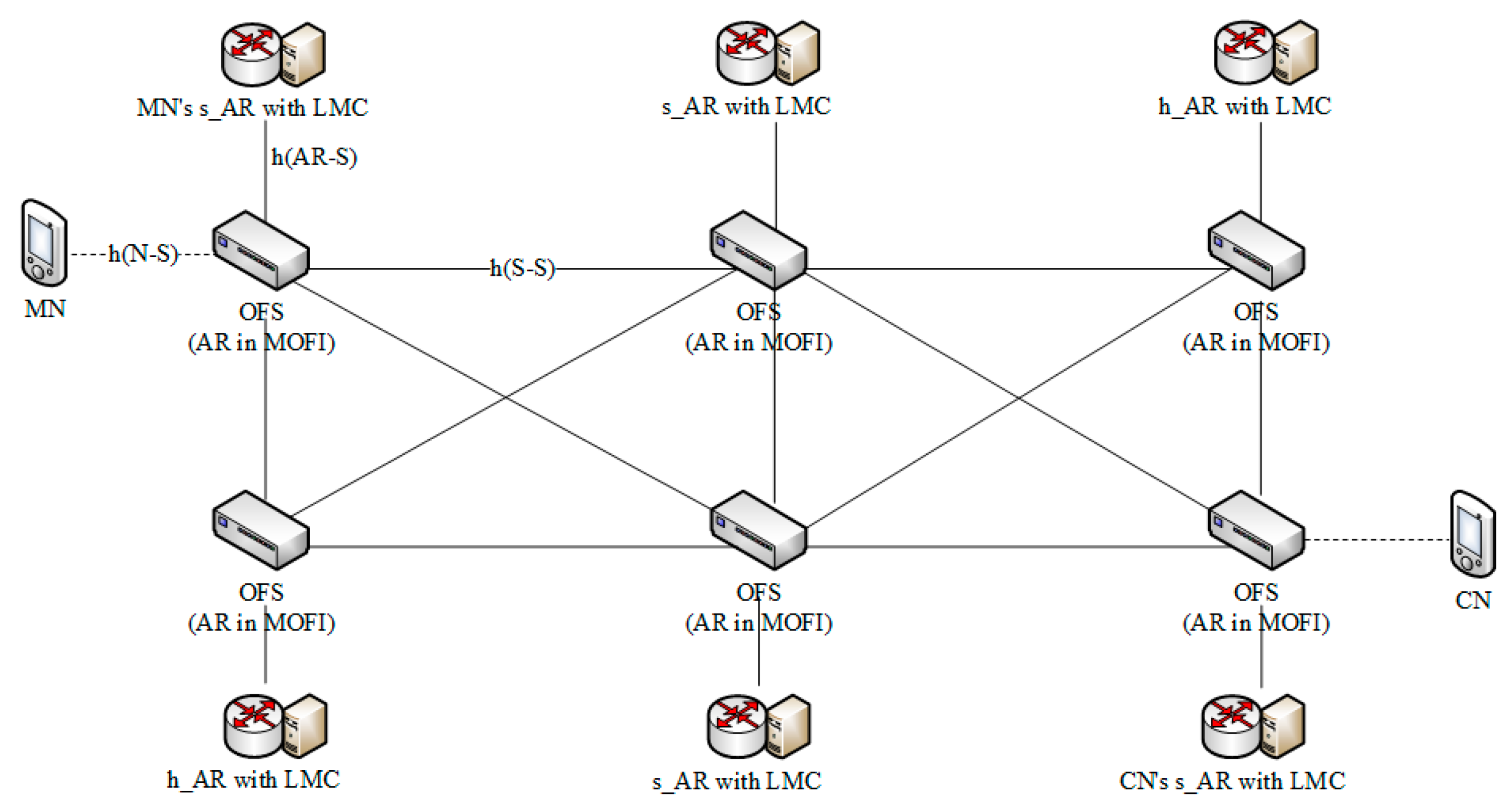
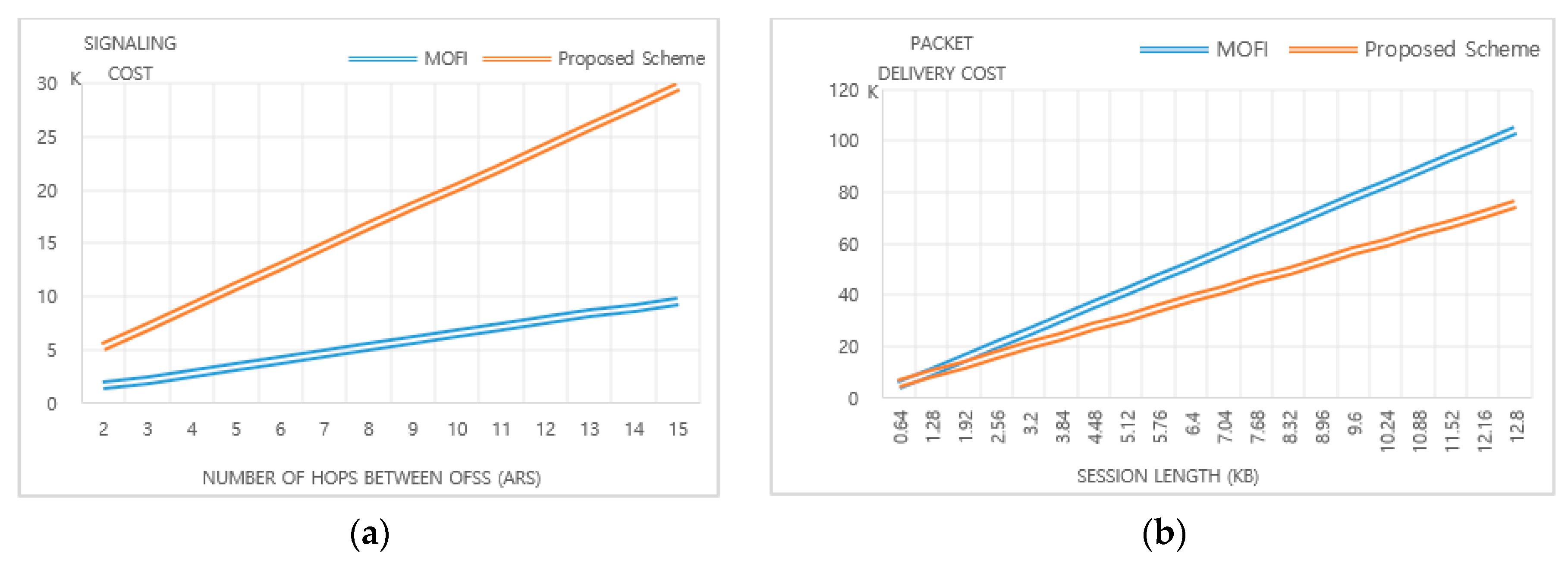
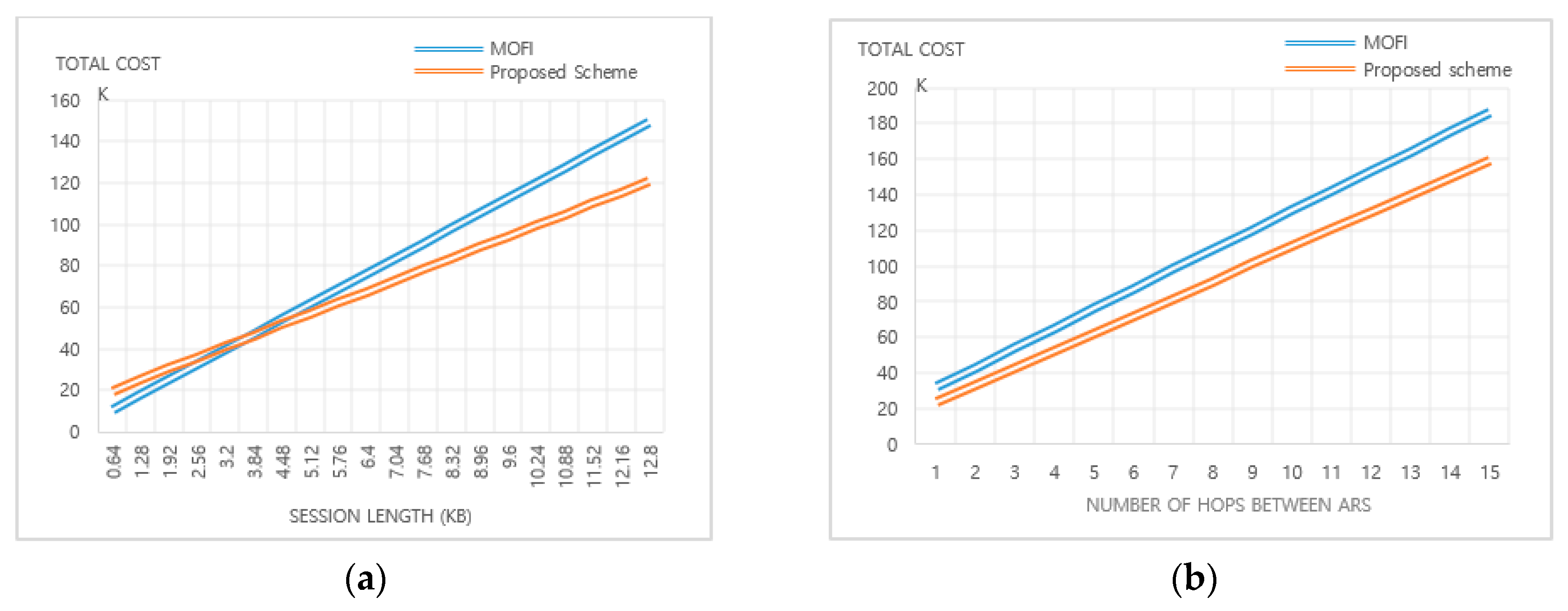
| Notation | Size (bytes) | Notation | Size (bytes) | Notation | Size (bytes) |
|---|---|---|---|---|---|
| 88 | 246 | 88 | |||
| 88 | 246 | 334 | |||
| 88 | 246 | 40 | |||
| 88 | 246 | 64 |
© 2020 by the authors. Licensee MDPI, Basel, Switzerland. This article is an open access article distributed under the terms and conditions of the Creative Commons Attribution (CC BY) license (http://creativecommons.org/licenses/by/4.0/).
Share and Cite
Lee, C.H.; Park, J.S. A Design for SDN-Based Identifier–Locator Separation Architecture on IoT Networks. Appl. Sci. 2020, 10, 2144. https://doi.org/10.3390/app10062144
Lee CH, Park JS. A Design for SDN-Based Identifier–Locator Separation Architecture on IoT Networks. Applied Sciences. 2020; 10(6):2144. https://doi.org/10.3390/app10062144
Chicago/Turabian StyleLee, Chan Haeng, and Ji Su Park. 2020. "A Design for SDN-Based Identifier–Locator Separation Architecture on IoT Networks" Applied Sciences 10, no. 6: 2144. https://doi.org/10.3390/app10062144
APA StyleLee, C. H., & Park, J. S. (2020). A Design for SDN-Based Identifier–Locator Separation Architecture on IoT Networks. Applied Sciences, 10(6), 2144. https://doi.org/10.3390/app10062144






